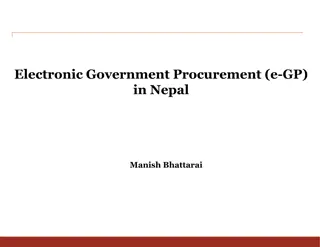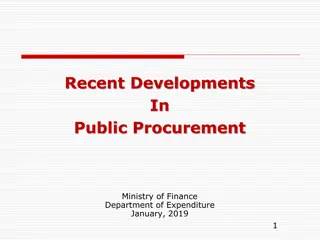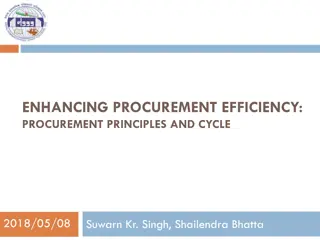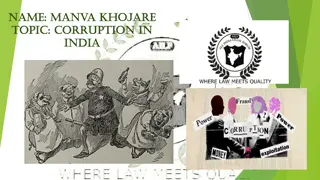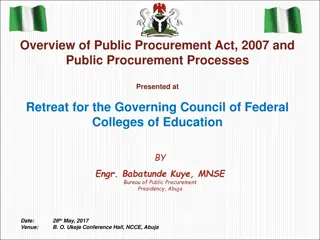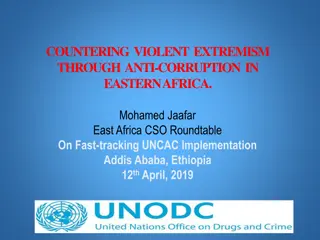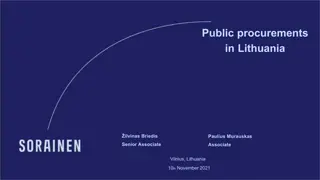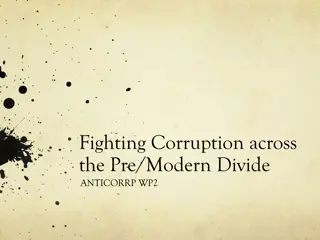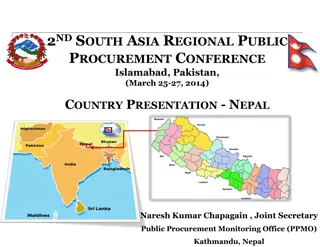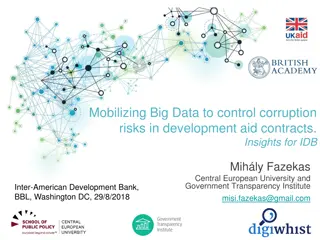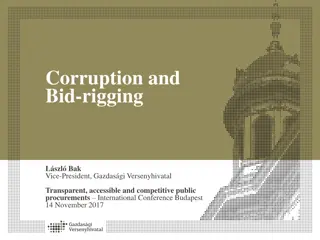Detecting Corruption in Public Procurement Using Big Data Techniques
This research focuses on objective detection of corruption in public procurement using big data, exploring frameworks for identifying corruption and collusion, along with examples of corruption techniques and indicators.
Download Presentation

Please find below an Image/Link to download the presentation.
The content on the website is provided AS IS for your information and personal use only. It may not be sold, licensed, or shared on other websites without obtaining consent from the author.If you encounter any issues during the download, it is possible that the publisher has removed the file from their server.
You are allowed to download the files provided on this website for personal or commercial use, subject to the condition that they are used lawfully. All files are the property of their respective owners.
The content on the website is provided AS IS for your information and personal use only. It may not be sold, licensed, or shared on other websites without obtaining consent from the author.
E N D
Presentation Transcript
BIG DATA BIG DATA & & CORRUPTION CORRUPTION RESEARCH RESEARCH IN IN PUBLIC PUBLIC PROCUREMENT PROCUREMENT Luis Garc a Vargas C sar Garz n cole nationale d administration publique (ENAP) Pierre-Andr Hudon Universit Laval INTERNATIONAL MEGAPROJECTS WORKSHOP JUNE 12-14, 2019 UQAM MONTREAL
THE PROBLEM Up until now, corruption research focused on perception For example: Transparency International s Corruption Perception Index What if there was a way to detect corruption objectively using big data? Public procurement is an ideal field in which to use big data related techniques because of the abundance of publicly available information INTERNATIONAL MEGAPROJECTS WORKSHOP JUNE 12-14, 2019 UQAM MONTREAL
BIG & OPEN DATA: THE FUTURE OF PUBLIC PROCUREMENT US$9.5 trillion per year (15% of global GDP)1 20-25% lost to corruption2 1. https://www.open-contracting.org/why-open-contracting/ 2. https://www.open-contracting.org/contratacion-abierta-por-que/?lang=es INTERNATIONAL MEGAPROJECTS WORKSHOP JUNE 12-14, 2019 UQAM MONTREAL
TWO FRAMEWORKS FOR DETECTING CORRUPTION AND COLLUSION DETECTING CORRUPTION Based on the works of: Fazekas & al. (2013 2018) Ferwerda & al. (2017) World Bank (2016) Public procurement corruption techniques and schemes are identified, modelled and converted into individual indicators When a contract is flagged by many indicators using an index score, it becomes suspicious DETECTION COLLUSION Based on the work of: Fazekas (2016) Kaway, K. et J. Nakabayashi (2014) Clark et al. (2015) Reeves-Latour (2016) Suspicious bidding patterns and market structures are identified using social network analysis Suspicions of price fixing are identified from bid data using similar techniques as the ones used for corruption detection INTERNATIONAL MEGAPROJECTS WORKSHOP JUNE 12-14, 2019 UQAM MONTREAL
CORRUPTION TECHNIQUES AND EXAMPLES OF INDICATORS LIMITING THE NUMBER OF BIDDERS CORRUPTING THE BID SELECTION PROCESS Only one compliant bid Call to tender cancelled Lengthy bid evaluation criteria Only one bid received Lengthy bidder eligibility criteria Geographical restrictions EX POST CONTRACT CHANGES Ex post contract value ( ) Changes during contract execution Contract extension(s) INTERNATIONAL MEGAPROJECTS WORKSHOP JUNE 12-14, 2019 UQAM MONTREAL
SIGNS OF COLLUSION AND EXAMPLES OF INDICATORS SUSPICIONS OF PRICE FIXING SUSPICIOUS MARKET STRUCTURES SUSPICIOUS BIDDING PATTERNS Overly concentrated market structure Falsely stable market structure Equal spread between bid prices Standard deviation of bid prices Bid price range Winning rate too high Cyclical winning Missing bidders Superfluous losing bidders in network SOCIAL NETWORK ANALYSIS INTERNATIONAL MEGAPROJECTS WORKSHOP JUNE 12-14, 2019 UQAM MONTREAL
APPLICATION WITH REAL WORLD DATA Quebec s Treasury Board Secretariat publishes public procurement contracts data since 2009: Over 200 000 contracts Over 600 000 bids The database s fields give very precise information about: The bidders (names, IDs, etc.) The bids (values, dates, etc.) The contract (ID, dates, values, addenda, etc.) From these precise information, corruption and collusion suspicion index scores (based on indicators) can be calculated EXAMPLES OF AVAILABLE DATA Document Tableau INTERNATIONAL MEGAPROJECTS WORKSHOP JUNE 12-14, 2019 UQAM MONTREAL
DEVELOPING AN INTEGRATED TOOL 1. Identify corruption and collusion schemes 4. Calculate a score per indicator for each contract 5. Compute an index score for each contract or sector 6. Identify suspicious contracts or sectors 2. Create an indicator for each scheme 3. Perform social network analysis Eventually: 1. 2. Intelligent parsing of call to tender documents Machine learning to identify which contract are suspicious of corruption based on automated social media/press monitoring Machine learning based on historical data of corrupt contracts 3. INTERNATIONAL MEGAPROJECTS WORKSHOP JUNE 12-14, 2019 UQAM MONTREAL
WHAT DOES IT MEAN FOR MEGAPROJECTS? In megaprojects, patterns are harder to detect: Fewer contracts with many subcontracts Projects are harder to compare because they are unique Procurement often done by private consortia s subcontractors Complex coordination structures: Multiple public bodies and intricate private consortia involved Multilevel financing and disclosure: Country, state/province, municipalities, supranational entities, multilateral institutions However, some solutions may exist: Widening the field using an international data base of megaprojects contracts Focusing on subcontracts requires changes to disclosure practices Pushing for more big data collection from multilateral financing agencies INTERNATIONAL MEGAPROJECTS WORKSHOP JUNE 12-14, 2019 UQAM MONTREAL
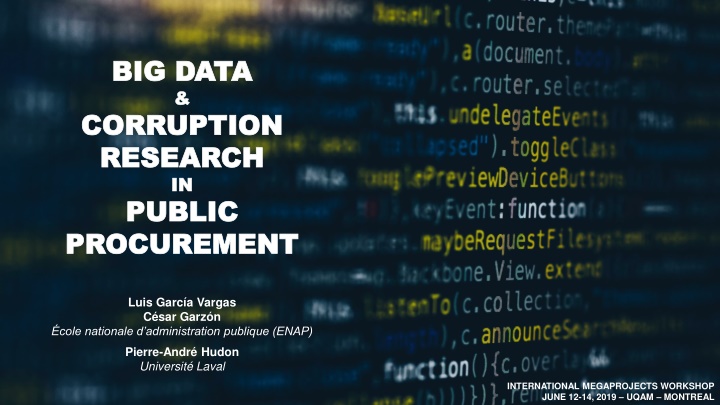

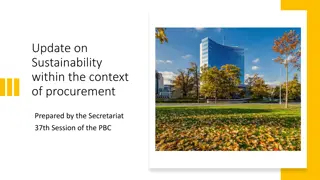


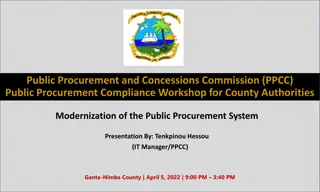
![Comprehensive Overview of Corruption Watch Submission on Public Procurement Bill [B18B-2023]](/thumb/138344/comprehensive-overview-of-corruption-watch-submission-on-public-procurement-bill-b18b-2023.jpg)
